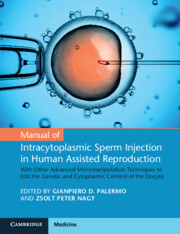 Manual of Intracytoplasmic Sperm Injection in Human Assisted Reproduction
Manual of Intracytoplasmic Sperm Injection in Human Assisted Reproduction Book contents
- Manual of Intracytoplasmic Sperm Injection in Human Assisted Reproduction
- Manual of Intracytoplasmic Sperm Injection in Human Assisted Reproduction
- Copyright page
- Contents
- Contributors
- Foreword
- Chapter 1 In Vitro Fertilization and Micromanipulation
- Chapter 2 Development of ICSI in Human Assisted Reproduction
- Chapter 3 Current ICSI Applications and Clinical Outcomes
- Chapter 4 Rescue ICSI of IVF Failed-Fertilized Oocytes
- Chapter 5 Morphological Sperm Selection Before ICSI
- Chapter 6 Laser-Assisted ICSI
- Chapter 7 Piezo: The Add-On to Standardize ICSI Procedure
- Chapter 8 Artificial Oocyte Activation After ICSI
- Chapter 9 Health of Children Born after Intracytoplasmic Sperm Injections (ICSI)
- Chapter 10 Examining the Safety of ICSI Using Animal Models
- Chapter 11 Cellular and Molecular Events after ICSI in Clinically Relevant Animal Models
- Chapter 12 Micromanipulation, Micro-Injection Microscopes and Systems for ICSI
- Chapter 13 Automation Techniques and Systems for ICSI
- Chapter 14 Germline Nuclear Transfer Technology to Overcome Mitochondrial Diseases and Female Infertility
- Chapter 15 Nuclear Transfer Technology and Its Use in Reproductive Medicine
- Chapter 16 The Prospects of Infertility Treatment Using “Artificial” Eggs
- Index
- Plate Section (PDF Only)
- References
Chapter 10 - Examining the Safety of ICSI Using Animal Models
Published online by Cambridge University Press: 02 December 2021
- Manual of Intracytoplasmic Sperm Injection in Human Assisted Reproduction
- Manual of Intracytoplasmic Sperm Injection in Human Assisted Reproduction
- Copyright page
- Contents
- Contributors
- Foreword
- Chapter 1 In Vitro Fertilization and Micromanipulation
- Chapter 2 Development of ICSI in Human Assisted Reproduction
- Chapter 3 Current ICSI Applications and Clinical Outcomes
- Chapter 4 Rescue ICSI of IVF Failed-Fertilized Oocytes
- Chapter 5 Morphological Sperm Selection Before ICSI
- Chapter 6 Laser-Assisted ICSI
- Chapter 7 Piezo: The Add-On to Standardize ICSI Procedure
- Chapter 8 Artificial Oocyte Activation After ICSI
- Chapter 9 Health of Children Born after Intracytoplasmic Sperm Injections (ICSI)
- Chapter 10 Examining the Safety of ICSI Using Animal Models
- Chapter 11 Cellular and Molecular Events after ICSI in Clinically Relevant Animal Models
- Chapter 12 Micromanipulation, Micro-Injection Microscopes and Systems for ICSI
- Chapter 13 Automation Techniques and Systems for ICSI
- Chapter 14 Germline Nuclear Transfer Technology to Overcome Mitochondrial Diseases and Female Infertility
- Chapter 15 Nuclear Transfer Technology and Its Use in Reproductive Medicine
- Chapter 16 The Prospects of Infertility Treatment Using “Artificial” Eggs
- Index
- Plate Section (PDF Only)
- References
Summary
There is no doubt that intracytoplasmic sperm injection (ICSI) has been a major breakthrough in treating male infertility, accounting for 70–80% of all the cycles performed worldwide. Surprisingly, there were very few animal studies conducted before the first babies were born, in part because of technical challenges that were experienced in most animal systems. Technological advancements were required to develop appropriate animal models for assessing the safety of ICSI. These studies identified many cytoskeletal changes that occurred in the oocyte cytoplasm after ICSI versus natural conception or even IVF, raising concerns about the long-term health of ICSI offspring. This chapter summarizes the animal models that have contributed to our understanding of the cellular and molecular aspects of ICSI, as well as providing models to investigate both the developmental origins of adult disease and transgenerational implications as they relate to ICSI.
Keywords
- Type
- Chapter
- Information
- Manual of Intracytoplasmic Sperm Injection in Human Assisted ReproductionWith Other Advanced Micromanipulation Techniques to Edit the Genetic and Cytoplasmic Content of the Oocyte, pp. 95 - 102Publisher: Cambridge University PressPrint publication year: 2021
